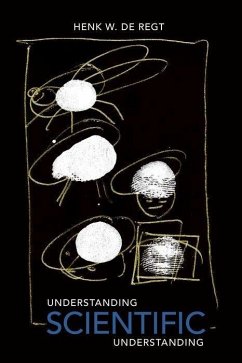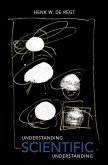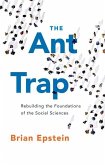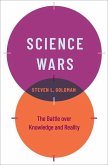Henk de Regt (Professo Professor of Philosophy of Natural Sciences
Understanding Scientific Understanding
Henk de Regt (Professo Professor of Philosophy of Natural Sciences
Understanding Scientific Understanding
- Broschiertes Buch
- Merkliste
- Auf die Merkliste
- Bewerten Bewerten
- Teilen
- Produkt teilen
- Produkterinnerung
- Produkterinnerung
Understanding is a central aim of science and highly important in present-day society. But what precisely is scientific understanding and how can it be achieved? This book answers these questions, through philosophical analysis and historical case studies, and presents a philosophical theory of scientific understanding that highlights its contextual nature.
Andere Kunden interessierten sich auch für
![Because Without Cause Because Without Cause]() Marc Lange (Chair of the Philos Chair of the Philosophy DepartmentBecause Without Cause62,99 €
Marc Lange (Chair of the Philos Chair of the Philosophy DepartmentBecause Without Cause62,99 €![Because Without Cause Because Without Cause]() Marc Lange (Chair of the Philos Chair of the Philosophy DepartmentBecause Without Cause192,99 €
Marc Lange (Chair of the Philos Chair of the Philosophy DepartmentBecause Without Cause192,99 €![Inventing Temperature Inventing Temperature]() Hasok Chang (Lecturer in the Department of Science and Technology SInventing Temperature43,99 €
Hasok Chang (Lecturer in the Department of Science and Technology SInventing Temperature43,99 €![Understanding Scientific Understanding Understanding Scientific Understanding]() Henk W de RegtUnderstanding Scientific Understanding148,99 €
Henk W de RegtUnderstanding Scientific Understanding148,99 €![Ant Trap Ant Trap]() Brian Epstein (Associate Profess Associate Professor of PhilosophyAnt Trap39,99 €
Brian Epstein (Associate Profess Associate Professor of PhilosophyAnt Trap39,99 €![Science Wars Science Wars]() Steven L. Goldman (Andrew W. Mellon Distinguished Professor in theScience Wars43,99 €
Steven L. Goldman (Andrew W. Mellon Distinguished Professor in theScience Wars43,99 €![Making Things Happen Making Things Happen]() James Woodward (Professor of Philosophy, Professor of Philosophy, CMaking Things Happen45,99 €
James Woodward (Professor of Philosophy, Professor of Philosophy, CMaking Things Happen45,99 €-
-
-
Understanding is a central aim of science and highly important in present-day society. But what precisely is scientific understanding and how can it be achieved? This book answers these questions, through philosophical analysis and historical case studies, and presents a philosophical theory of scientific understanding that highlights its contextual nature.
Hinweis: Dieser Artikel kann nur an eine deutsche Lieferadresse ausgeliefert werden.
Hinweis: Dieser Artikel kann nur an eine deutsche Lieferadresse ausgeliefert werden.
Produktdetails
- Produktdetails
- Oxford Studies in Philosophy of Science
- Verlag: Oxford University Press Inc
- Seitenzahl: 320
- Erscheinungstermin: 1. Februar 2020
- Englisch
- Abmessung: 233mm x 157mm x 22mm
- Gewicht: 448g
- ISBN-13: 9780197510261
- ISBN-10: 0197510264
- Artikelnr.: 58602614
- Herstellerkennzeichnung
- Libri GmbH
- Europaallee 1
- 36244 Bad Hersfeld
- gpsr@libri.de
- Oxford Studies in Philosophy of Science
- Verlag: Oxford University Press Inc
- Seitenzahl: 320
- Erscheinungstermin: 1. Februar 2020
- Englisch
- Abmessung: 233mm x 157mm x 22mm
- Gewicht: 448g
- ISBN-13: 9780197510261
- ISBN-10: 0197510264
- Artikelnr.: 58602614
- Herstellerkennzeichnung
- Libri GmbH
- Europaallee 1
- 36244 Bad Hersfeld
- gpsr@libri.de
Henk W. de Regt is Professor of Philosophy of Natural Sciences at the Instititute for Science in Society, Radboud University Nijmegen, The Netherlands.
* Preface
* Acknowledgement
* Chapter 1. Introduction: The desire to understand
* Chapter 2. Understanding and the aims of science
* 2.1. The neglect of understanding
* 2.2. Understanding as an epistemic skill
* 2.3. Intelligibility, values, and objectivity
* 2.4. Understanding: a means and an end
* Chapter 3. Explanatory understanding: A plurality of models
* 3.1. From covering law explanation to unificatory understanding
* 3.2. Causal conceptions of explanatory understanding
* 3.3. Is causal and unificatory understanding complementary?
* 3.4. Unifying the plurality of modes of explanation
* Chapter 4. A contextual theory of scientific understanding
* 4.1. Understanding phenomena with intelligible theories
* 4.2. Criteria for intelligibility
* 4.3. Conceptual tools for understanding
* 4.4. The context-dependence of understanding
* 4.4.1. Contextuality and historical dynamics
* 4.4.2. Contextuality and the intuitions of philosophers
* 4.4.3. Contextuality and pragmatics
* 4.5. Reduction, realism and understanding
* 4.5.1. Understanding and realism
* 4.5.2. Understanding and reduction
* 4.6. Contextualism: risky relativism?
* Chapter 5. Metaphysics and intelligibility: Understanding gravitation
* 5.1. The (un)intelligibility of Newton's theory of universal
gravitation
* 5.2. The seventeenth-century debate on gravitation
* 5.2.1. Isaac Newton: reluctant revolutionary
* 5.2.2. Christiaan Huygens: the conscience of corpuscularism
* 5.3. Actio in distans and intelligibility after Newton
* 5.4. Metaphysics as a resource for scientific understanding
* Chapter 6. Models and mechanisms: Physical understanding in the
nineteenth century
* 6.1. Mechanical modeling in nineteenth-century physics
* 6.1.1. William Thomson: master modeler
* 6.1.2. James Clerk Maxwell: advocate of analogies
* 6.1.3. Ludwig Boltzmann: promoter of pictures
* 6.2. Molecular models for understanding gas phenomena
* 6.3. Boltzmann' Bildtheorie: a pragmatic view of understanding
* 6.4. The uses and limitations of mechanical models
* Chapter 7. Visualizability and intelligibility: Insight into the
quantum world
* 7.1. Visualizability and intelligibility in classical physics
* 7.2. Quantum theory and the waning of Anschaulichkeit
* 7.3. The new quantum mechanics: a struggle for intelligibility
* 7.4. Electron spin: the power of visualization
* 7.5. Visualization in post-war quantum physics
* 7.6. Visualization as a tool for understanding
* Chapter 8. Conclusion: the many faces of understanding
* Bibliography
* Index
* Acknowledgement
* Chapter 1. Introduction: The desire to understand
* Chapter 2. Understanding and the aims of science
* 2.1. The neglect of understanding
* 2.2. Understanding as an epistemic skill
* 2.3. Intelligibility, values, and objectivity
* 2.4. Understanding: a means and an end
* Chapter 3. Explanatory understanding: A plurality of models
* 3.1. From covering law explanation to unificatory understanding
* 3.2. Causal conceptions of explanatory understanding
* 3.3. Is causal and unificatory understanding complementary?
* 3.4. Unifying the plurality of modes of explanation
* Chapter 4. A contextual theory of scientific understanding
* 4.1. Understanding phenomena with intelligible theories
* 4.2. Criteria for intelligibility
* 4.3. Conceptual tools for understanding
* 4.4. The context-dependence of understanding
* 4.4.1. Contextuality and historical dynamics
* 4.4.2. Contextuality and the intuitions of philosophers
* 4.4.3. Contextuality and pragmatics
* 4.5. Reduction, realism and understanding
* 4.5.1. Understanding and realism
* 4.5.2. Understanding and reduction
* 4.6. Contextualism: risky relativism?
* Chapter 5. Metaphysics and intelligibility: Understanding gravitation
* 5.1. The (un)intelligibility of Newton's theory of universal
gravitation
* 5.2. The seventeenth-century debate on gravitation
* 5.2.1. Isaac Newton: reluctant revolutionary
* 5.2.2. Christiaan Huygens: the conscience of corpuscularism
* 5.3. Actio in distans and intelligibility after Newton
* 5.4. Metaphysics as a resource for scientific understanding
* Chapter 6. Models and mechanisms: Physical understanding in the
nineteenth century
* 6.1. Mechanical modeling in nineteenth-century physics
* 6.1.1. William Thomson: master modeler
* 6.1.2. James Clerk Maxwell: advocate of analogies
* 6.1.3. Ludwig Boltzmann: promoter of pictures
* 6.2. Molecular models for understanding gas phenomena
* 6.3. Boltzmann' Bildtheorie: a pragmatic view of understanding
* 6.4. The uses and limitations of mechanical models
* Chapter 7. Visualizability and intelligibility: Insight into the
quantum world
* 7.1. Visualizability and intelligibility in classical physics
* 7.2. Quantum theory and the waning of Anschaulichkeit
* 7.3. The new quantum mechanics: a struggle for intelligibility
* 7.4. Electron spin: the power of visualization
* 7.5. Visualization in post-war quantum physics
* 7.6. Visualization as a tool for understanding
* Chapter 8. Conclusion: the many faces of understanding
* Bibliography
* Index
* Preface
* Acknowledgement
* Chapter 1. Introduction: The desire to understand
* Chapter 2. Understanding and the aims of science
* 2.1. The neglect of understanding
* 2.2. Understanding as an epistemic skill
* 2.3. Intelligibility, values, and objectivity
* 2.4. Understanding: a means and an end
* Chapter 3. Explanatory understanding: A plurality of models
* 3.1. From covering law explanation to unificatory understanding
* 3.2. Causal conceptions of explanatory understanding
* 3.3. Is causal and unificatory understanding complementary?
* 3.4. Unifying the plurality of modes of explanation
* Chapter 4. A contextual theory of scientific understanding
* 4.1. Understanding phenomena with intelligible theories
* 4.2. Criteria for intelligibility
* 4.3. Conceptual tools for understanding
* 4.4. The context-dependence of understanding
* 4.4.1. Contextuality and historical dynamics
* 4.4.2. Contextuality and the intuitions of philosophers
* 4.4.3. Contextuality and pragmatics
* 4.5. Reduction, realism and understanding
* 4.5.1. Understanding and realism
* 4.5.2. Understanding and reduction
* 4.6. Contextualism: risky relativism?
* Chapter 5. Metaphysics and intelligibility: Understanding gravitation
* 5.1. The (un)intelligibility of Newton's theory of universal
gravitation
* 5.2. The seventeenth-century debate on gravitation
* 5.2.1. Isaac Newton: reluctant revolutionary
* 5.2.2. Christiaan Huygens: the conscience of corpuscularism
* 5.3. Actio in distans and intelligibility after Newton
* 5.4. Metaphysics as a resource for scientific understanding
* Chapter 6. Models and mechanisms: Physical understanding in the
nineteenth century
* 6.1. Mechanical modeling in nineteenth-century physics
* 6.1.1. William Thomson: master modeler
* 6.1.2. James Clerk Maxwell: advocate of analogies
* 6.1.3. Ludwig Boltzmann: promoter of pictures
* 6.2. Molecular models for understanding gas phenomena
* 6.3. Boltzmann' Bildtheorie: a pragmatic view of understanding
* 6.4. The uses and limitations of mechanical models
* Chapter 7. Visualizability and intelligibility: Insight into the
quantum world
* 7.1. Visualizability and intelligibility in classical physics
* 7.2. Quantum theory and the waning of Anschaulichkeit
* 7.3. The new quantum mechanics: a struggle for intelligibility
* 7.4. Electron spin: the power of visualization
* 7.5. Visualization in post-war quantum physics
* 7.6. Visualization as a tool for understanding
* Chapter 8. Conclusion: the many faces of understanding
* Bibliography
* Index
* Acknowledgement
* Chapter 1. Introduction: The desire to understand
* Chapter 2. Understanding and the aims of science
* 2.1. The neglect of understanding
* 2.2. Understanding as an epistemic skill
* 2.3. Intelligibility, values, and objectivity
* 2.4. Understanding: a means and an end
* Chapter 3. Explanatory understanding: A plurality of models
* 3.1. From covering law explanation to unificatory understanding
* 3.2. Causal conceptions of explanatory understanding
* 3.3. Is causal and unificatory understanding complementary?
* 3.4. Unifying the plurality of modes of explanation
* Chapter 4. A contextual theory of scientific understanding
* 4.1. Understanding phenomena with intelligible theories
* 4.2. Criteria for intelligibility
* 4.3. Conceptual tools for understanding
* 4.4. The context-dependence of understanding
* 4.4.1. Contextuality and historical dynamics
* 4.4.2. Contextuality and the intuitions of philosophers
* 4.4.3. Contextuality and pragmatics
* 4.5. Reduction, realism and understanding
* 4.5.1. Understanding and realism
* 4.5.2. Understanding and reduction
* 4.6. Contextualism: risky relativism?
* Chapter 5. Metaphysics and intelligibility: Understanding gravitation
* 5.1. The (un)intelligibility of Newton's theory of universal
gravitation
* 5.2. The seventeenth-century debate on gravitation
* 5.2.1. Isaac Newton: reluctant revolutionary
* 5.2.2. Christiaan Huygens: the conscience of corpuscularism
* 5.3. Actio in distans and intelligibility after Newton
* 5.4. Metaphysics as a resource for scientific understanding
* Chapter 6. Models and mechanisms: Physical understanding in the
nineteenth century
* 6.1. Mechanical modeling in nineteenth-century physics
* 6.1.1. William Thomson: master modeler
* 6.1.2. James Clerk Maxwell: advocate of analogies
* 6.1.3. Ludwig Boltzmann: promoter of pictures
* 6.2. Molecular models for understanding gas phenomena
* 6.3. Boltzmann' Bildtheorie: a pragmatic view of understanding
* 6.4. The uses and limitations of mechanical models
* Chapter 7. Visualizability and intelligibility: Insight into the
quantum world
* 7.1. Visualizability and intelligibility in classical physics
* 7.2. Quantum theory and the waning of Anschaulichkeit
* 7.3. The new quantum mechanics: a struggle for intelligibility
* 7.4. Electron spin: the power of visualization
* 7.5. Visualization in post-war quantum physics
* 7.6. Visualization as a tool for understanding
* Chapter 8. Conclusion: the many faces of understanding
* Bibliography
* Index








